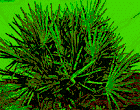Saw Palmetto
Serenoa repens
Family: Palmae
by Darlene S. Widirstky

DESCRIPTION:
Saw palmetto, also known as sabal is native to the West Indies and the southeastern part of the United States. You can still find this small palm tree growing naturally in scrub pine areas or on sandy beaches from South Carolina to the Florida Keys. While most saw palmettos are only a few feet tall, some protected ones have grown to heights of 20´ or more and may be 500 to 700 years old.
Saw palmetto grows in clumps. Each plant produces between 3 to 7 leaves each year and they remain alive for about 2 years. Stalks grow upright on the sprawled trunks, giving the illusion of many separate plants. They are deeply divided into stiffly outspread narrow segments. Sharp spiny projections often exist along the edges of the compressed leaf petiole. Hence, its common name...saw palmetto. They are pollinated by insects and are a favorite of honeybees. Oblong, ¾" fruits, sometimes referred to as berries, are then produced. They mature during the summer, turning in color from green to yellow, then to orange-red, and finally to a bluish-black when the fruit is ripe.
In Southwest Florida, it is something of a culinary delight. Some people use the terminal buds in salads. Harvesting the buds does not kill the plant and they say it is "tastier than cabbage palm bud". The fruit is sometimes available at local farm stands. In fact, that is how it became of particular interest to the medical community. It was noted that both animals and humans appeared to be exceptionally healthy when these ripe berries were part of their diet. After some research it was found that Native Americans relied on this fruit for both food and medicine. It was used to treat head colds, irritated throat and nose passages, chronic bronchitis, asthma, and certain sexual disorders. They also used it to improve digestion as well as a tonic in treating wasting diseases.
Saw palmetto is available as dried ground fruit in tablet or capsule as well as extract form. This herb is promoted as being highly beneficial for mature men. They say it is helpful in maintaining a healthy prostate, in increasing the flow of urine, and in reducing the frequency of nighttime urination. Healthy men might consider taking this as a preventative herbal supplement.
What men want to prevent is benign prostate hyperplasia (BPH, also known as benign prostatic hypertrophy). This problem affects nearly 60% of the male population between the ages of 40 and 60. Some typical symptoms might include the frequent urge to urinate, incomplete bladder emptying, interrupted sleep due to the urge to get up to urinate. Frequently there is a burning sensation when urinating, and there may be a penetrating pain in the bladder.
These may be symptomatic of many problems. All of these symptoms can be caused by the prostate, a doughnut shaped gland the size of a walnut which lies below the bladder and surrounds the male urethra. The prostate enlarges, causing the above symptoms. If left untreated BPH will progress, causing secondary infections in the urethra, bladder, and/or kidneys. Additional symptoms might include severe chills and high fever. I mention the above symptoms just for your information, prostate ailments should never be self-diagnosed. A licensed medical doctor is necessary in order to perform a physical examination and take standard blood and urine samples. Once a diagnosis for BPH has been made, treatment may simply consist of taking antibiotics with follow-up doctor visits; or it may be necessary to resort to more radical treatment, including surgery. This would be the case if the person neglects the symptoms and does not seek medical treatment. Annual costs of hospital care and surgery are estimated at one billion dollars in the United States alone. Both doctors and patients are opting for a gentler approach to curing BPH; a non-traumatic, biological, nutritional approach. Saw palmetto is believed to be nature%acute;s medicine for the treatment of prostate problems.
(To my knowledge these statements have not been evaluated by the FDA. This product is not intended to diagnose, treat, cure, or prevent any disease.)
Current theory (at the time of gathering material for this article) on the cause of BPH is that testosterone is converted into dihydrotestosterone which is responsible for causing the prostate enlargement, and which causes BPH.
Today, a concentrated extract of the berries is a choice of doctors in France, Germany, and many other European countries. They believe it to be far more beneficial than conventional treatment whether it be prescription drugs or surgery. Mild side effects occur in 5% of the patients. The most common side effects were mild nausea, constipation, diarrhea, and headaches.
Sixty percent of the male population is at risk to BPH. If taking a simple daily herbal supplement might help prevent it, wouldn´t you want to know? Saw palmetto as an herbal supplement for most men 18 years and older sounds like a good idea to me. Getting a yearly physical that includes prostate testing is also a good idea. A professional should know enough about their patient to make any recommendations. As with all any medication, your doctor should know what you are presently taking, whether it is prescription or an over-the-counter drug, as well as any herbal supplements.
Bibliography upon request.